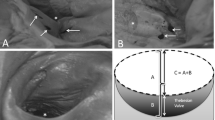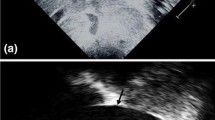Abstract
Interest in transseptal catheterization has increased in recent decades, due to the fact that the technique has acquired a degree of security similar to other procedures. For a correct transseptal catheterization technique, it is essential to know the exact location of the fossa ovalis, its points of reference, and those morphologic parameters which allow us to assume precisely its dimensions. For this purpose, 97 human fresh hearts were studied (age range: 17-94 years; mean 63.74 ± 18.50, 62 (64%) men and 35 (36%) women). The major and minor diameters of the fossa ovalis and the thickness of the intervenous tubercle were measured. In 22% of the cases, the fossa ovalis was permeable. Correlative tests between morphologic and general parameters were made. A positive correlation between cardiac weight and fossa ovalis area, and cardiac weight and thickness of the anterior limbus of the fossa was obtained.
Similar content being viewed by others
Author information
Authors and Affiliations
Rights and permissions
About this article
Cite this article
Reig, J., Mirapeix, R., Jornet, A. et al. Morphologic characteristics of the fossa ovalis as an anatomic basis for transseptal catheterization. Surg Radiol Anat 19, 279–282 (1998). https://doi.org/10.1007/s00276-997-0279-0
Received:
Accepted:
Issue Date:
DOI: https://doi.org/10.1007/s00276-997-0279-0




